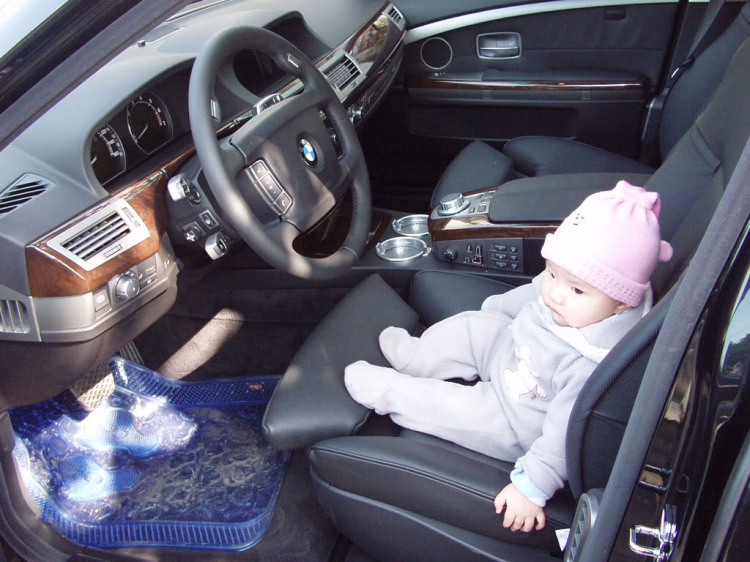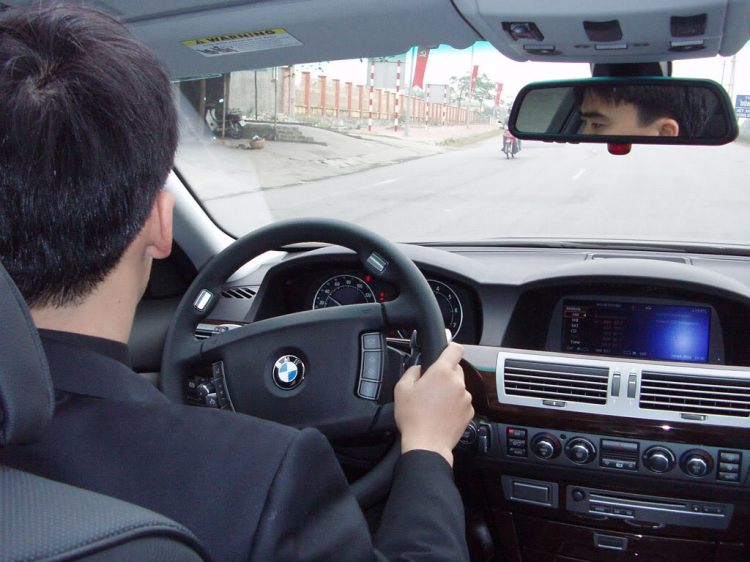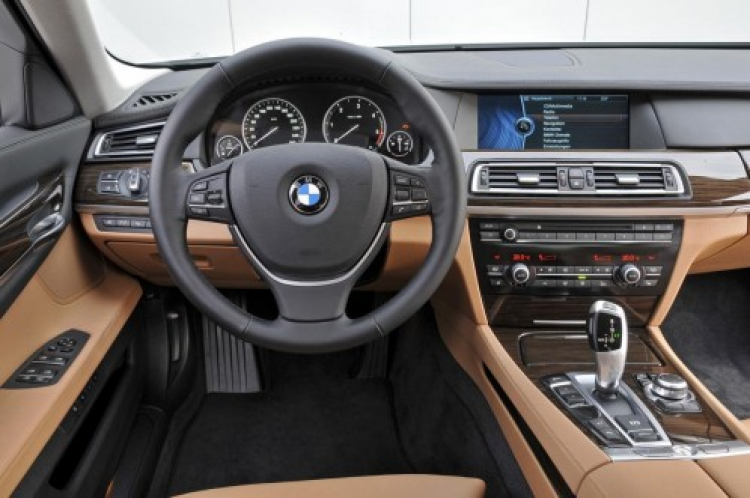BMW 7-series: You say you want an evolution - BMW 7 Series sets new standards for luxury cars
Never mind the hype, BMW's next 7-series is a technological marvel that sets new standards for luxury cars, says Peter Dron
We are at Miramas in the blazing heat of the Camargue, where the mosquitoes are as big as fruit bats, to sample BMW's fifth-generation 7-series. Here in 1926 Bugatti scored its first-ever French Grand Prix victory, though only three cars turned up, all Bugattis, and only two finished.
BMW bought this 191-acre site in 1986; all models since have been partly developed here. The facility now has 32 miles of test routes: a high-speed banked circuit and various handling tracks, including one with water sprinklers, an FIA-approved grand prix test circuit, even an exact replica of the Nürburgring's fearsome Karussell corner. The original racing circuit, an oval, and its tiny grandstand, have been preserved.
To business. BMW makes bold claims for its latest executive express. We are here to check them and to decipher jargon: "Optimum Driving Dynamics", "Integrated Chassis Management", "Integral Active Steering", "Precise Elegance", "Superior Sportiness". But first, a bit more history…
A brief history of BMW codes, E to F
BMW fans can be tediously knowledgeable about E-codes, an internal identification system adopted in the 1960s. E stands for Entwicklung (evolution). Since the first 7-series (E23), in 1977, complete redesigns have emerged roughly every seven years, total production exceeding 1.2 million. Replacing the outgoing E65 (E66 with long wheelbase), this car is the first F: F01 (standard) and F02 (long wheelbase). The final E-car, E99, is a five-door "PAS" (Progressive Activity Sedan, whatever that means), 7-series-based, Mercedes R-class rival. Already shown as a concept, its production version will be F07. So, farewell then, Entwicklung. Missing you already. F for… Well, moving along into the future…
When? How much?
In Britain on November 15. Initial range comprises: 730d (£54,160), "first representative of a new generation of straight-six diesel engines" and "121lb lighter than its predecessor"; 740i (£57,550) and long-wheelbase 740Li (£60,600), "the most powerful straight-six within BMW's entire range of engines"; 750i (£66,450) and 750Li (£69,400), "world's most efficient V8 petrol engine". We drove only V8s.
Will it fit your garage?
Probably, if you are a potential 7-series buyer. Chief rivals are Audi's A8 and the Mercedes-Benz S-class. The BMW is now the biggest of these, an orange-pip longer than the Merc, with the longest wheelbase.
Does it feel that big?
No. Cue Optimum Driving Dynamics. Sounds ODD, but it works. Our test route included a corner so tight that it would normally necessitate selecting reverse at least once in the Li (17ft between the bumpers). During such manoeuvres, the car seems to shrink in your hands.
The new 7-series has a battery of high-technology fitments includes a night vision pedestrian warning system
How does it do that?
IAS: Integral Active Steering (optional, but essential). Following a similarly equipped car through slow corners, you can see its rear wheels turn slightly, following the same arc as the front wheels (ie turning in the opposite direction), reducing the turning circle by more than 27in. As Arnold Kistler, 7-series model development manager, said: "Anybody who has ever manoeuvred a large car in an underground garage or under similar conditions will definitely appreciate this feature as a significant improvement in comfort."
What about at higher speeds?
When travelling faster, IAS's electronically monitored system turns the rear wheels up to three degrees in the same direction as the fronts; the front-wheel steering angle is also adjusted when necessary. The new 7 feels as nimble as a 3-series on the move.
As standard, the car has Dynamic Damper Control including Dynamic Driving Control. Responding to road conditions and driving style, this infinitely adjusts bump and rebound, preventing excessive reactions to surface irregularities or fast lateral acceleration.
We tested the 750i and the 750iL on the old racing oval, through a slalom at more than 80mph, adjusting (via a console switch) settings - Comfort, Standard, Sport, Sport+. Rising up this scale, steering response progressively increases and the suspension tautens, noticeably reducing roll. Our testing also included varied surfaces and bends, using the different suspension modes. In town most owners will use Comfort, which effortlessly absorbs low-speed vertical shocks, and Normal elsewhere. Sport (giving "the classic BMW feel") is ideal for more interesting roads, and is particularly impressive over rapid undulations. Sport+ reduces Dynamic Stability Control (DSC) intervention. We tackled the wet handling circuit in various modes and the system really flatters the driver. Then we switched off the DSC. Hilarious… I advise against this in heavy rain.
What about the looks?
As design director, Chris Bangle created the controversial E65. Now promoted to the Board (where he can cause less harm, some suggest), his influence remains evident. The man who once said in an interview, "It's post-modern in many ways, implying that you are integrating multiple concepts into one totality," must also be responsible for these formulae for BMW's design philosophy: "Natural Presence… Superior Sportiness… Precise Elegance." Let us toast the demise of imprecise elegance.
To my eyes, this latest iteration of the big four-door is a major improvement on its ungainly predecessor, and there are some clever details. When I interviewed Bangle ( Motoring, July 27, 2002), he provided a complex explanation of why the tail of the E65 - vulgarly known as "the Bangle butt" - had to be that way. His employees evidently disagree. The transition from C-pillar into tail section of the F01/F02 is much smoother, while the styling line, all the way from headlamps to tail lights, is subtly crafted.
However, after leaving Miramas I saw an E38, the pre-Bangle 7-series (1994-2001), which is perhaps the handsomest big car ever. Nowhere, from bumper to bumper, is there any exaggeration. Few designers achieve such deceptive simplicity without descending into blandness. It looks easy when done well.
Peter Stevens, doyen of British car designers, has an interesting explanation of BMW's dilemma: "The E38 was just about the perfect culmination of a process of refinement that had taken about 10 years. Where to go from there? The wilderness, at first. By slavishly following a rather narrow design path that relies more on refinement than creativity you can eventually find yourself in a cul-de-sac without an alternative philosophy to help find a new direction." I tried to get him to express an opinion on the new 7. He said that he had examined it, including that long side feature incorporating the door handles, but kept dozing off.
Inside story
Highlight of a typically elegant BMW interior is a greatly improved iDrive command module: the heating/air-con controls have been extracted, while important driving functions are relocated to a small console on the left of the wheel, and "infotainment" buttons to a similar console on the right. One no longer has the feeling that an intensive training course is required. The iDrive screen is a 10.2in LCD panel with 1280x480 resolution, and the whole centre panel is angled towards the driver.
Which 7 for you?
Our chauffeur patiently struggled through heavy morning traffic from our hotel in Marseille to Miramas, 40 miles away. We were wafted smoothly along in the outgoing (E66) 730Li - long-wheelbase, petrol straight-six - mechanically a classic BMW, hard to fault as a passenger, from which viewpoint the "Bangle butt" is invisible. Out on the autoroute, we were provided with a useful reminder that the base model does the job about 10 times better than adequately. Anything else is indulgence.
Britain's best-selling E65/E66 was the 730d, taking 68 per cent of sales last year, with the 730Ld second, on 21 per cent. This "entry-level" 7 gives you all the comfort, more than adequate performance, and the best tax rating. The 740i (3.0-litre petrol) will probably be marginally nicer to drive. Then there is the V8. Does it justify the extra wedge? That's your decision.
Later versions may include the Hydrogen 7 or a hybrid. Try to convince your neighbours that you have made an ecological choice. A 4x4 model is rumoured, a wise choice if all this global warming stuff is nonsense and we are actually heading for an Ice Age. Otherwise, forget it. There will almost certainly be a V12, ideal for sneering at your "green" neighbour.
Which options?
Standard equipment is lavish, but there is a substantial options list. You can have Lane Departure Warning, Proximity Warning, steering wheel heater (put yer gloves on, Parker), powered bootlid, "comfort access", "soft-close" doors, non-standard wheels, a device that spots drunken jaywalkers in the dark, etc. Two essentials: Dynamic Drive (£1,610) and Integral Active Steering (£1,195). The head-up display option (£915), adjustable to suit drivers of different heights, works well.
Nguồn : telegraph.co.uk/












